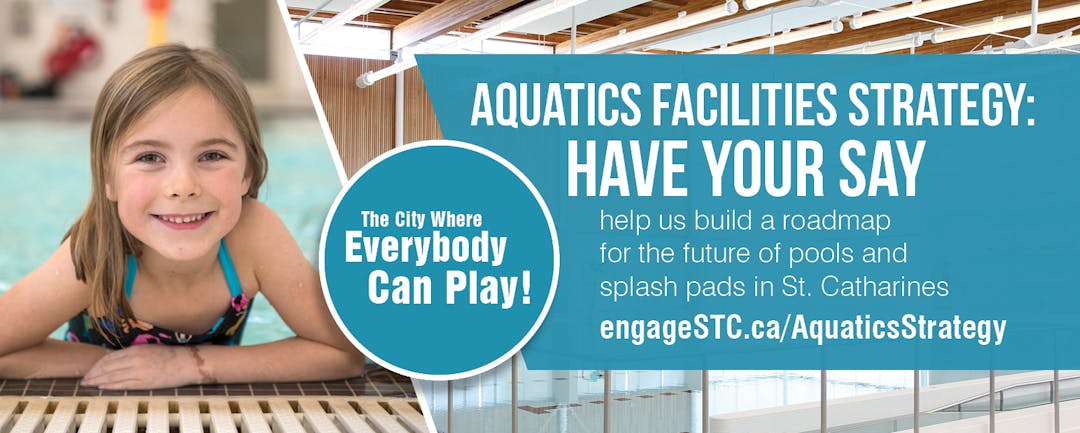Make a splash: weigh in on aquatic facilities strategy
Consultation has concluded

St. Catharines is a city where everybody can play, and that extends to our pools and splash pads.
We’re looking to the future, developing an Aquatics Facilities Strategy, to ensure that for years to come residents can enjoy current and future aquatics facilities. The strategy will provide a snapshot of where aquatics facilities and programming stand; what works and what doesn’t; and provide a roadmap for future improvements and investments into facilities and programming.
Draft Aquatic Facilities Strategy Online Open House
Building on previous public engagement through the Aquatic Facilities Strategy Community Survey, research and stakeholder engagement staff have completed a draft Aquatic Facilities Strategy for public review. The draft strategy outlines the current landscape of aquatic facilities in the City, current and future trends in facility use and challenges. Based on this three implementation strategies are presented as possible guides for future aquatic facilities in the city.
Current conditions
The City currently boasts one indoor aquatics facility, the St. Catharines Kiwanis Aquatics Centre; three outdoor pools and four splash pads.
Facility conditions:
- Aquatic centre and splash pads at Bogart Street Park and West Park are in excellent condition
- All outdoor pools are more than 40 years old, don't meet accessibility standards, and are nearing the end of their useful life requiring redevelopment to meet modern standards
- Pearson Park and Catherine Street Park splash pads are in good condition
Trends:
- Demand is increasing for indoor, year-round aquatics
- Outdoor pools seeing decreasing demand in favor of indoor opportunities, limited opening season, and increased splash pad use for cool-down activities
- Increased demand for aquatics programming
- Wait lists for current indoor aquatics programming
- The City's population is projected to grow by 13,000 in the next 10 years, driving increased demand
Implementation strategies
The draft Aquatic Facilities Strategy presents three possible implementation strategies - Balanced, Refocused and Status Quo - to address, in varying degrees, increasing demand and shifting trends in aquatics preferences.
Balanced Implementation Strategy:
In this approach the City would build a new indoor aquatics facility, and redevelop Lion Dunc Schooley Outdoor Pool. The other two outdoor pools would be closed. Additionally three splash pads would be built, providing a splash pad for each Ward, resulting in a compliment of seven splash pads, one outdoor pool, and two indoor aquatics facilities for the city. This strategy would provide substantially greater programming capacity to meet increasing demand.
Capital cost: $25 million to $31 million
Operating costs over 20 years: $26 million
Refocused Implementation Strategy:
In this approach the City would build a new indoor aquatics facility and close all three of its outdoor pools. Additionally three splash pads would be built, providing a splash pad fore each Ward, resulting in a compliment of seven splash pads and two indoor aquatics facilities for the city. This strategy would provide some increases in programming capacity, although outdoor swimming programming would be completely eliminated.
Capital cost: $19 million to $22 million
Operating costs over 20 years: $22 million
Status Quo Implementation Strategy:
In this approach the City would maintain its current inventory of aquatics facilities with no new pools, indoor aquatics facilities or splash pads. The City would retain its current array of one indoor aquatics facility, three outdoor pools and four splash pads. This strategy would create no increased capacity for facility access or programming, even as demand increases. This strategy still presents a considerable cost to the City as all three outdoor pools present a need to be completely redeveloped, not only to ensure their continued operations but also to meet new requirements under the Access for Ontarians with Disabilities Act. Modern designs features and accessibility requirements also mean these redeveloped pools would likely have reduced capacity after redevelopment.
Capital cost: $11 million to $16 million
Operating costs over 20 years: $8.2 million
Draft Aquatic Facilities Strategy Presentation
Please watch the following presentation for an in-depth look at the draft strategy.
Click here to view the full draft Aquatic Facilities Strategy
Feedback now closed
Feedback for our Aquatics Facilities Strategy closed Feb. 23. We will work to answer any questions and consider all feedback in the finalization of the strategy. Thank you!
